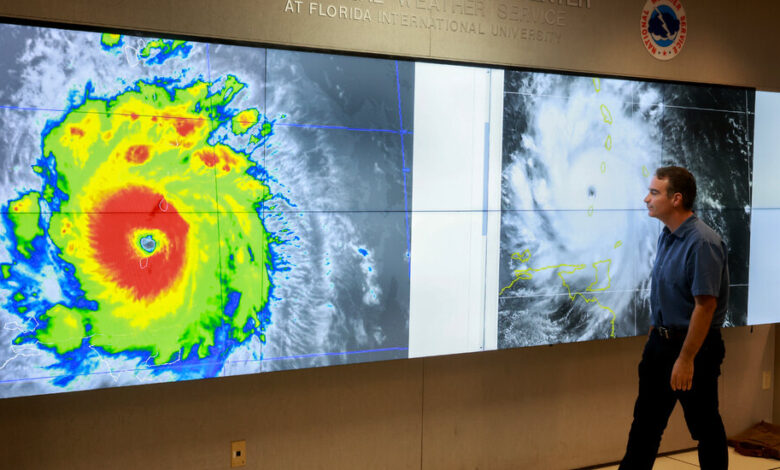Hurricane Beryl Flattens Grenada’s Carriacou Island

A powerful Category 4 hurricane began sweeping through the eastern Caribbean Islands on Monday, making a devastating landfall on Carriacou, a small island north of Grenada, officials said.
In a briefing broadcast on social media, Prime Minister Dickon Mitchell of Grenada said that Carriacou had been “flattened” in just half an hour and that government officials also expected “extreme” damage on the neighboring island of Petite Martinique.
The force of Hurricane Beryl — the first of this year’s season — left a trail of destruction in its path as it made landfall: trees snapped in half, extensive storm surge and roofs blown off as winds reached more than 150 miles per hour.
There was no power on any of the islands and communication was difficult, officials said.
Mr. Mitchell said that the complete scale of the damage on Carriacou and Petite Martinique would not be clear until Monday evening, adding that he would travel to Carriacou as soon as it was safe to do so.
“There was devastation all around,” the prime minister said. “We therefore expect that we will have to quickly transition into damage assessment and recovery and stabilization mode.”
Early reports of damage also emerged in Grenada’s capital, St. George’s, as the storm passed over the main island. The roof of a police station was ripped away and a hospital had to evacuate patients to a lower level after its roof sustained damage.
Beryl was an anomaly in what is already an unusually busy storm season, which extends until the end of November. According to forecasters, it is the third major hurricane ever in the Atlantic Ocean in June — and the first time a Category 4 has materialized this early there in the season.
“Incredible doesn’t cut it. This truly is something else of a hurricane,” Noah Bergren, a meteorologist for Fox 35 Orlando in Florida, said on X. “Will be a fast moving storm, but for a few hours will be just hell on earth.”
The storm was also historic for the short time it took to strengthen from a tropical depression to a major hurricane — 42 hours — a direct result of the above-average sea surface temperatures. The quick escalation was a feat recorded only six other times in Atlantic hurricane history.
Officials in Barbados said on Monday that the island had been spared the worst of Beryl.
The prime minister of Barbados, Mia Mottley, told a nationwide broadcast from the island’s emergency operations center that as many as 20 fishing boats, including two popular cruisers, had possibly sunk. Still, she added, “This could have been far worse for us.”
Roughly 40 homes were known to have sustained roof or structural damage so far, she said, though that number was expected to rise as more than 400 residents returned home from shelters.
People across the eastern Caribbean had started preparing for the storm over the weekend, including those doing some last-minute shopping for supplies.
“Hurricanes are not something that we take lightly at home as a family,” said Fleur Mathurin, who lives on St. Lucia, where some parts of the island were experiencing power outages. “Having my family, my grandmothers, great-grands, gone through Hurricane Allen and Gilbert, this is something that they always preach to us.”
As of Monday afternoon, the storm was expected to continue tearing its way through the Caribbean, reaching Jamaica with potential hurricane conditions by Wednesday according to the National Hurricane Center.
Julius Gittens contributed reporting from Christ Church, Barbados; Linda Straker from Gouyave, Grenada; Kenton X. Chance from Kingstown, St. Vincent; Sharefil Gaillard from Gros Islet, St. Lucia; and Maria Abi-Habib from Mexico City.






